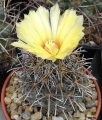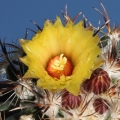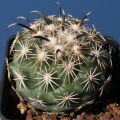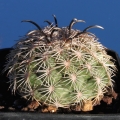
Coryphantha kracikii Photo by: Agócs György
Origin and Habitat: This species is endemic to the Mexican state of Durango, where it is known from a single location.
Type locality: El Diamante Durango.
Altitude: Approximately 1400 meters above sea level.
Habitat: It grows among stones on gravelly, calcareous soils in desert scrub along with a rich succulent flora comprising: Hamatocactus hamatacanthus, Mammillaria pottsiiSN|9355]]SN|9355]], Glandulicactus uncinatusSN|3474]]SN|3474]], Echinomastus unguispinusSN|14901]]SN|14901]], Echinocactus horizonthaloniusSN|1711]]SN|1711]] and Yucca rostrataSN|27871]]SN|27871]].
Synonyms:
Description: Coryphantha kracikiiSN|10252]]SN|10252]] is a solitary stemmed cactus densely covered with impressive spines and is one of the most beautiful coryphanthas especially as a young plant.
Stem: The spherical to short columnar up to 17 cm tall and 9 cn broad.
Tubercles: Broad cylindrical-conical, 12-16 mm long fissured. Axils initially filled with wool.
Central spines: 5 to 8 spreading, slightly curved up to 2,5 cm long, black with a lighter tip, then brown and eventually turning grey.
Radial spines: 24 to 26 needle-like, dimorphic, light to dark horn-coloured up to 1,5 cm long. The upper 12 to 18 white with a darker tips, up to 2,5 cm long, somewhat thinner, converging and almost touching but not fused.
Flowers: 4-8 cm in diameter, yellow with a red throat.
Fruits: Olive-like up to 2,5 cm long and 1,5 cm in diameter.
Bibliography: Major references and further lectures
1) Edward F. Anderson “Das große Kakteen-Lexikon.” Eugen Ulmer KG, Stuttgart 2005 (übersetzt von Urs Eggli), ISBN 3-8001-4573-1, page 153.
2) Urs Eggli, Leonard E. Newton “Etymological Dictionary of Succulent Plant Names” Springer, Berlin/Heidelberg 2010, page 128.
3) Cactaceae etc. Volume 12, number 1, 2002 page 12–13.
4) Goettsch, B.K. 2013. Coryphantha kracikii. The IUCN Red List of Threatened Species. Version 2015.2. <www.iucnredlist.org>. Downloaded on 26 July 2015.
 Coryphantha kracikii Photo by: Valentino Vallicelli
Coryphantha kracikii Photo by: Valentino Vallicelli Coryphantha kracikii Photo by: Prof. Ilham Alakbarov
Coryphantha kracikii Photo by: Prof. Ilham Alakbarov Coryphantha kracikii Photo by: Valentino Vallicelli
Coryphantha kracikii Photo by: Valentino Vallicelli Coryphantha kracikii Photo by: Valentino Vallicelli
Coryphantha kracikii Photo by: Valentino Vallicelli Juvenile specimen. Photo by: Valentino Vallicelli
Juvenile specimen. Photo by: Valentino Vallicelli Adult Photo by: Prof. Ilham Alakbarov
Adult Photo by: Prof. Ilham Alakbarov Coryphantha kracikii Photo by: Valentino Vallicelli
Coryphantha kracikii Photo by: Valentino Vallicelli Coryphantha kracikii Photo by: Valentino Vallicelli
Coryphantha kracikii Photo by: Valentino VallicelliCultivation and Propagation: In culture Coryphantha kracikiiSN|10252]]SN|10252]] is without problems and regularly shows its large yellow flowers. It is a summer-growing species of easy cultivation but sensitive to overwatering (rot prone).
Growth rate: Slow growing. It needs about 8-12 years to reach the typical, definite outlook.
Soil: Grow it in an open sandy-gritty cactus compost.
Pots: It needs a relatively shallow pot to accommodate its fibrous roots and provide a very good drainage. They may stay in the same pot for many years.
Watering: Water in moderation, it prefer a completely dry place during winter. Mature individuals easily rot and die especially after planting so be extremely cautious with watering. Keep dry in winter or when night temperatures remain below 10° C. Water it less than average if in bigger pots.
Special need: Provide very good ventilation. Nearly all problems occur as a result of overwatering and poor ventilation, especially when weather conditions are dull and cool or very humid.
Fertilization: Feed them once during the growing season with a fertilizer specifically formulated for cactus and succulents (high potash fertilizer with a dilute low nitrogen), including all micro nutrients and trace elements diluted to ½ the strength recommended on the label. They thrive in poor soils and need a limited supplies of fertilizer to avoid the plants developing excess vegetation, which is easily attacked by fungal diseases.
Exposure: It will do its best with lots of sun and become stressed with inadequate light which could result in poor growth and unnatural shape.
Hardiness: It likes warmth (recommended minimum winter temperature 5° C) however plants kept perfectly dry can can survive low temperatures, approx. -5°, but for safe cultivation it is best to avoid freezing temperatures.
Use: It can be cultivated outdoors in raised beds, terraces if sheltered from winter rain.
Pests & diseases: These cacti may be attractive to a variety of insects, but plants in good condition should be nearly pest-free, particularly if they are grown in a mineral potting-mix, with good exposure and ventilation. Nonetheless, there are several pests to watch for:
- Red spiders: Red spiders may be effectively rubbed up by misting the plants from above.
- Mealy bugs: Mealy bugs occasionally develop aerial into the new growth and flowers with disfiguring results, but the worst types develop underground on the roots and are invisible except by their effects.
- Rot: Rot is only a minor problem if the plants are watered and “aired” correctly. If they are not, fungicides won't help all that much.
Propagation: Seeds. The seeds can be sown in pots of fine, well-drained sandy soil, any time during the spring when temperatures are warm. Cover the seeds with a fine layer of grit and water from below with a fungicide to prevent damping off. For the 1-2 weeks cover the pots with a sheet of glass/clear perspex to keep the humidity levels high. Remove the glass and replace it with light shade-cloth and mist once or twice a day for the next two weeks after which most seeds should have germinated. From then on mistings can be reduced to every second and then every third day as the little plants grow.
Your Photos

by Agócs György

by Valentino Vallicelli

by Valentino Vallicelli

by Valentino Vallicelli

by Valentino Vallicelli























